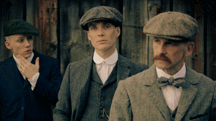A FEW YEARS ago the BBC announced they were going to move away from making Jane Austen adaptations and other period dramas and concentrate instead on dramas with periods, places and people TV audiences had rarely seen on the small screen.

And this new focus has come to glorious fruition with the much-acclaimed crime drama Peaky Blinders, which centers on the rise of a crime gang in post-World War One Birmingham. The show debuted on BBC Two to huge acclaim last year and season two is currently being broadcast in the UK. Netflix have just made the show available on the USA.
Described by one critic as a mash-up of Boardwalk Empire and Brighton Rock, the show stars Cillian Murphy as crime boss Tommy Shelby, with sterling support from Helen McCrory as matriarch Aunt Polly, and Joe Cole as Tommy’s little brother John. The show also features an ice-cool soundtrack and is shot through with self-conscious references to the great American gangster films such as Once Upon a Time in America and features a pub that looks straight out of a Western. And despite the bleak surroundings of impoverished Brum neighborhoods Bordesley and Small Heath, the thugs are nothing if not stylish, as screenwriter Steven Knight explains:
“Peaky Blinders was a name that used to mean something once in Birmingham….Peaky Blinders were real-life teenage hoodlums in the 1890s. They wore donkey fringes and bell bottom trousers whose width had to be measured precisely, and big buckles. Then, as these kids grew up, the term also came to mean anyone on the wrong side of the law.”
But still the clothes mattered to the original Peaky Blinders gang, which was in reality on the wane by the 1920s. Most important were their caps, which gave them their name. Razorblades were sewn in just shy of the peaks, and with these the gangsters could blind a victim, or slash his ear off.
A Birmingham man himself, Knight has been trying to get his drama made for nearly two decades and has a personal connection to the story. His mother as a child was a bookies’ runner – delivering illegal bets to the city’s self-styled bookmakers. “There was this whole network of illegal gambling at the time,” says Knight. “And in one area of Birmingham it was organised and run by my Dad’s uncles – who were the Peaky Blinders.”
Knight recalls a tale his father told him about his father being sent, at the age of about 10 in the 1920s, to deliver a message to his own father’s brothers. “He walked into this room and there was a gang of men all immaculately dressed, they looked incredibly glamorous. They were drinking tea out of jam jars because they spent all their money on clothes. And they were standing around a table piled high with money.”
It was this image that inspired Knight to create his story, which focuses on the efforts of the fictional Shelbys, a family of illegal bookmakers, to better themselves in 1919. Their tale is set against a backdrop of the slums of Birmingham, then one of the most important industrial cities in the world, but one riven by the chaos left by the end of the war: social unrest, communist dissidence, strikes – even the police went on strike in 1919. There was also the threat of the IRA, one of the reasons Tommy Shelby’s nemesis, the Northern Irish police inspector CI Campbell, played by Sam Neill, is brought over from Belfast by the then Secretary of State Winston Churchill to clean up the city.
Although the show is anchored by Murphy strong central performance, McCrory’s Aunt Polly is also essential to the family dynamic. The actress was quick to reject accusations by one critic that the show glamorizes immorality.
“The whole idea of morality in this period, with the rise of feminism and communism, was up in the air; as well as the question of the morality of sending the boys who fought in the war to their deaths,” says McCrory. “Aunt Polly’s no more immoral than the people around her.”
“The Peaky Blinders are like the Borgias in nail boots. These are highly intelligent people surviving the only way they know how.”
[adrotate group=”8″]
